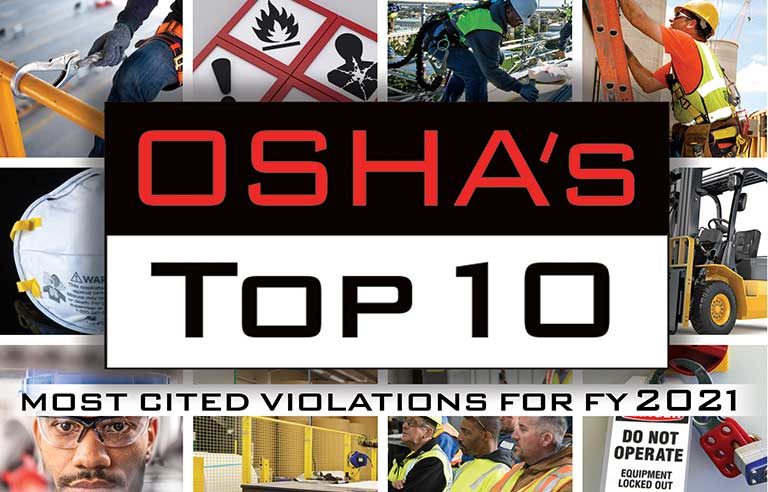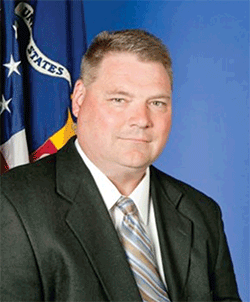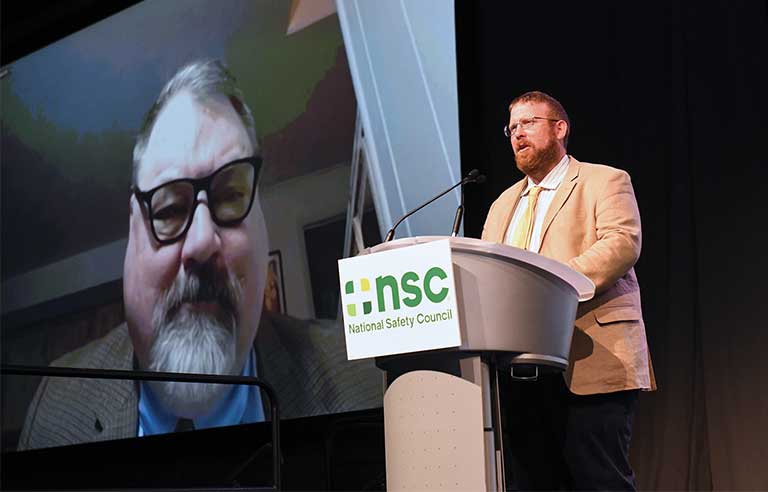OSHA’s Top 10 most cited violations for FY 2021

Q & A with OSHA's Patrick Kapust
 Preliminary data for OSHA’s Top 10 most cited violations for fiscal year 2021 was announced Oct. 12 during the 2021 NSC Safety Congress & Expo in Orlando, FL. Weeks later, Patrick Kapust, deputy director of OSHA’s Directorate of Enforcement Programs, spoke with Safety+Health Associate Editor Kevin Druley to discuss the list, as well as actions safety and health professionals can take to help correct hazards in their workplaces.
Preliminary data for OSHA’s Top 10 most cited violations for fiscal year 2021 was announced Oct. 12 during the 2021 NSC Safety Congress & Expo in Orlando, FL. Weeks later, Patrick Kapust, deputy director of OSHA’s Directorate of Enforcement Programs, spoke with Safety+Health Associate Editor Kevin Druley to discuss the list, as well as actions safety and health professionals can take to help correct hazards in their workplaces.
Safety+Health: Why do you believe Fall Protection – General Requirements has remained in the No. 1 spot for so long?
Kapust: Fall hazard violations continue to top the list because they are present in so many workplaces, whether from the use of stairways, ladders, scaffolding, unprotected floor holes, wall openings or any activity carried out on an elevated work surface. Employers need to evaluate their workplaces to identify and abate fall hazards on a continual basis – not just once at the beginning of a job or process. Each year, the agency hosts a national campaign to raise awareness and encourage fall prevention. For more information on that program, you can visit our website at osha.gov/stop-falls.
S+H: Electrical – General Requirements (1910.303) and Electrical – Wiring Methods (1910.305) each held spots on the list when you first presented the Top 10 in November 2011. These days, neither standard is a mainstay on the list. In what ways have employers been effective in mitigating electrical hazards?
Kapust: Well, OSHA is pleased to see that Electrical – General Requirements and Wiring Methods are not on the Top 10 list, although it must be noted that both remain in the top 15 frequently issued citations. From our work, we’ve discovered that those employers with successful electrical safety programs focus first on employee training and safe work practices. Additionally, qualified employees are able to recognize electrical hazards and implement effective abatement strategies through comprehensive preventive maintenance and self-inspections.
S+H: How has the COVID-19 pandemic affected enforcement activities? What influence have you seen in regard to Respiratory Protection?
Kapust: During the pandemic, OSHA developed new ways of prioritizing and conducting inspections, such as remote inspections via phone or fax, as well as responding to complaints and referrals while ensuring the protection of our own field staff. OSHA area offices have continued to use their resources to fulfill mission-essential functions that allow flexibility and discretion so that our field offices can maximize OSHA’s impact in securing safe workplaces for workers and agency staff in these evolving environments. OSHA addressed enforcement of existing general industry health and safety standards, especially those in high-risk industries like meat and poultry processing. Previously, the agency developed policies that allowed certain enforcement discretions – which have now been rescinded – due to nationwide shortages of personal protective equipment, quarantines, business shutdowns and limited availability of contractors to perform medical services. OSHA’s website provides information on COVID-related whistleblower activity and the number of complaints received.
The pandemic had a slight influence on Respiratory Protection violations. In relation to the total number of inspections made during the pandemic, the percentages of cited Respiratory Protection violations increased from 5.3% in FY 2020 to 6.5% in FY 2021. The agency continues to provide compliance assistance through media outreach, guidance documents and memoranda to aid employers in protecting their workers from SARS-CoV-2 – the virus that causes COVID-19.
S+H: Previously, you mentioned that the agency would continue to take a balanced approach to enforcement under the Biden administration. After nearly a year, to what extent has that been the case?
Kapust: Enforcement, training and compliance assistance remain key elements in OSHA’s approach to workplace safety and health. I strongly believe that each component drives and supports the others. OSHA has the White House’s support to move forward with key safety and health initiatives such as heat illness prevention in indoor and outdoor work settings. The enforcement program office continues to work closely with other directorates within OSHA to develop strategic approaches to ensure the protection of America’s workers.

Safety+Health Associate Editor Kevin Druley (right), was joined via Zoom by Patrick Kapust, deputy director of OSHA’s Directorate of Enforcement Programs, to present the Top 10 list of most cited violations for fiscal year 2021 at the 2021 NSC Safety Congress & Expo in Orlando, FL.
Kapust: Because OSHA cannot inspect every workplace, we must be creative in the way that we message our mission to reach as many workplaces as possible. We know that other employers pay attention to our press releases, especially when it impacts someone in their industry or in their local community. Press releases can impact a company’s business profile, their ability to bid for work and their competition in the marketplace. We hope the press releases will encourage others to take proactive steps to address safety and health before an incident occurs or before a compliance safety and health officer arrives to conduct an inspection. And there are a lot of excellent resources available to do just that, including the Onsite Consultation Program and OSHA’s compliance assistance specialists.
S+H: What updates can you give on national enforcement initiatives or National Emphasis Programs that are in the works? What kind of impact can NEPs have on the Top 10?
Kapust: In January, OSHA released its revised National Emphasis Program for respirable crystalline silica, targeting employers in construction, general industry and maritime, and enforcing OSHA’s silica standards that were issued in 2016. Although silica exposures are wide-ranging among America’s workplaces, the agency does not expect citations for violations of the new silica standard to make the Top 10 list of OSHA’s most frequently cited violations.
In March, a new national enforcement initiative was issued to address the COVID-19 pandemic and its effect on America’s workers. The NEP was revised in July after the agency issued an emergency temporary standard for COVID-19 in health care, and will be reviewed again after issuance of the new ETS for COVID-19 vaccinations, testing and face coverings among employers with 100 or more employees.
In September, OSHA issued a nationwide enforcement initiative to prevent and protect employees from serious heat-related illnesses while working in hazardous indoor or outdoor environments. Working conditions that have resulted in serious heat-related illnesses occur in all major industry sectors, including general industry, construction, agriculture and maritime. An increase in worker illnesses and fatalities is possible if outdoor and indoor work settings are without adequate climate-controlled environments. However, the agency does not expect future citations for heat-related hazards issued under the General Duty Clause to make the Top 10 list of OSHA’s most frequently cited violations.
S+H: What advice would you give to employers to help them avoid being a statistic in next year’s Top 10 list?
Kapust: Employers should review their work processes and determine the hazards in their workplace by completing job hazard analyses, encourage employees to report workplace hazards and unsafe conditions, train employees to recognize hazards related to the Top 10 list, and expand training to other workplace hazards. Employers should also review their injury and illness logs and implement measures to eliminate identified hazards.
S+H: Where can employers turn for help to avoid violations that appear on the Top 10 list?
Kapust: Small and medium-sized employers who need assistance with identifying and correcting hazards in the workplace should contact the nearest OSHA consultation program. That can be found on our website at osha.gov/consultation. They can request an onsite, no-cost visit from that program.
S+H: What haven’t I asked that you think S+H readers should know?
Kapust: I’d just like to reiterate that, as safety and health professionals, your readers are on the front lines to make a difference for workers in America and to really make an impact on the way employers approach workplace safety and health. As workplaces return to full capacity, in some cases with fewer employees, it is even more important to make sure that safety and health remain a critical part of reentry procedures.
| Citation Solutions: Visit the websites of Safety+Health advertisers offering products and services to help you avoid OSHA’s Top 10 most cited violations. | Next: Citation Solutions > |
Post a comment to this article
Safety+Health welcomes comments that promote respectful dialogue. Please stay on topic. Comments that contain personal attacks, profanity or abusive language – or those aggressively promoting products or services – will be removed. We reserve the right to determine which comments violate our comment policy. (Anonymous comments are welcome; merely skip the “name” field in the comment box. An email address is required but will not be included with your comment.)

